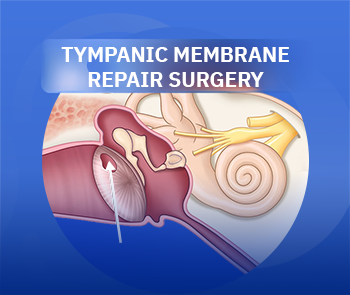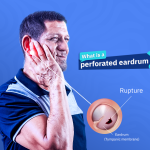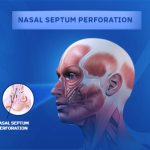Tympanoplasty

The eardrum can become perforated due to several reasons, such as exposure to loud noises or inserting solid objects into the ear. Therefore, tympanoplasty is considered the most effective treatment for such perforations.
The eardrum is a very thin, cone-shaped membrane that separates the outer auditory canal from the ossicles of the middle ear. It functions by transmitting sound waves from the external ear to the ossicles in the middle ear.
In this article, we will explore everything related to tympanoplasty, including:
- What is Tympanoplasty?
- Causes of Tympanic Membrane Perforation
- Symptoms of a Perforated Eardrum
- Treatment Options for Tympanic Membrane Perforation
- Preparing for Tympanoplasty
- Potential Complications of Tympanoplasty
- Postoperative Care After Tympanoplasty
- Assessing the Success of Tympanoplasty
What is Tympanoplasty?
Tympanoplasty is a surgical procedure aimed at repairing a perforation or tear in the tympanic membrane (eardrum). In certain cases, it may also involve the reconstruction of the three ossicles located behind the eardrum. The primary goal of this surgery is to restore the integrity of the eardrum and improve hearing
Causes of Tympanic Membrane Perforation
Several factors can lead to a perforated eardrum, including:
- Ear infections: Chronic or severe infections can cause the eardrum to rupture.
- Exposure to loud noises: Sudden or prolonged exposure to high-decibel sounds can damage the eardrum.
- Insertion of foreign objects: Using objects like cotton swabs or sharp items can puncture the eardrum
- Barotrauma: Rapid changes in air pressure, such as during air travel or scuba diving, can cause the eardrum to rupture.
Symptoms of a Perforated Eardrum
Common signs indicating a perforated eardrum include:
- Ear pain
- Discharge from the ear, which may be bloody or clear
- Hearing loss
- Tinnitus (ringing in the ear)
- A feeling of fullness in the ear
- Dizziness or vertigo
Treatment Options for Tympanic Membrane Perforation
While many eardrum perforations heal on their own within a few weeks, medical intervention may be necessary in certain cases:
- Non-surgical patching: An ENT specialist may apply a paper patch or a special gel to promote healing.
- Surgical repair (Tympanoplasty): If the perforation is large or does not heal with conservative measures, tympanoplasty may be performed. This involves grafting tissue, often from the patient’s own body, to close the hole in the eardrum.
Preparing for Tympanoplasty
Before undergoing tympanoplasty, patients should:
- Inform their doctor about any allergies.
- Disclose all medications and supplements being taken.
- Follow preoperative instructions, which may include fasting after midnight before the surgery.
Potential Complications of Tympanoplasty
While tympanoplasty is generally safe, potential risks include:
- Bleeding
- Infection at the surgical site
- Damage to the facial nerve
- Persistent perforation if the graft does not take
- Temporary or permanent changes in taste
Postoperative Care After Tympanoplasty
Proper care after surgery is crucial for recovery:
- Keep the ear dry; avoid swimming and use ear protection during showers.
- Avoid strenuous activities and heavy lifting.
- Follow the doctor’s instructions regarding medications and follow-up appointments.
- Report any signs of infection or complications to the healthcare provider promptly.
Assessing the Success of Tympanoplasty
Success is typically evaluated through follow-up visits, where the doctor will:
- Examine the eardrum to ensure proper healing.
- Conduct hearing tests to assess improvement.
Adhering to postoperative instructions and attending all follow-up appointments are essential for optimal outcomes.







